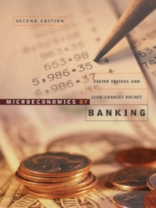The second edition of an essential text on the microeconomic foundations of banking surveys the latest research in banking theory, with new material that covers recent developments in the field.Over the last thirty years, a new paradigm in banking theory has overturned economists’ traditional vision of the banking sector. The asymmetric information model, extremely powerful in many areas of economic theory, has proven useful in banking theory both for explaining the role of banks in the economy and for pointing out structural weaknesses in the banking sector that may justify government intervention. In the past, banking courses in most doctoral programs in economics, business, or finance focused either on management or monetary issues and their macroeconomic consequences; a microeconomic theory of banking did not exist because the Arrow-Debreu general equilibrium model of complete contingent markets (the standard reference at the time) was unable to explain the role of banks in the economy. This text provides students with a guide to the microeconomic theory of banking that has emerged since then, examining the main issues and offering the necessary tools for understanding how they have been modeled.This second edition covers the recent dramatic developments in academic research on the microeconomics of banking, with a focus on four important topics: the theory of two-sided markets and its implications for the payment card industry; "non-price competition" and its effect on the competition-stability tradeoff and the entry of new banks; the transmission of monetary policy and the effect on the functioning of the credit market of capital requirements for banks; and the theoretical foundations of banking regulation, which have been clarified, although recent developments in risk modeling have not yet led to a significant parallel development of economic modeling.Praise for the first edition:"The book is a major contribution to the literature on the theory of banking and intermediation. It brings together and synthesizes a broad range of material in an accessible way. I recommend it to all serious scholars and students of the subject. The authors are to be congratulated on a superb achievement."-Franklin Allen, Nippon Life Professor of Finance and Economics, Wharton School, University of Pennsylvania"This book provides the first comprehensive treatment of the microeconomics of banking. It gives an impressive synthesis of an enormous body of research developed over the last twenty years. It is clearly written and apleasure to read. What I found particularly useful is the great effort that Xavier Freixas and Jean-Charles Rochet have taken to systematically integrate the theory of financial intermediation into classical microeconomics and finance theory. This book is likely to become essential reading for all graduate students in economics, business, and finance."-Patrick Bolton, Barbara and David Zalaznick Professor of Business, Columbia University Graduate School of Business"The authors have provided an extremely thorough and up-to-date survey of microeconomic theories of financial intermediation. This work manages to be both rigorous and pleasant to read. Such a book was long overdue and shouldbe required reading for anybody interested in the economics of banking and finance."-Mathias Dewatripont, Professor of Economics, ECARES, Universit
Xavier Freixas & Jean-Charles Rochet
Microeconomics of Banking [PDF ebook]
Microeconomics of Banking [PDF ebook]
¡Compre este libro electrónico y obtenga 1 más GRATIS!
Idioma Inglés ● Formato PDF ● Páginas 392 ● ISBN 9780262273176 ● Editorial The MIT Press ● Publicado 2008 ● Descargable 3 veces ● Divisa EUR ● ID 7972765 ● Protección de copia Adobe DRM
Requiere lector de ebook con capacidad DRM












